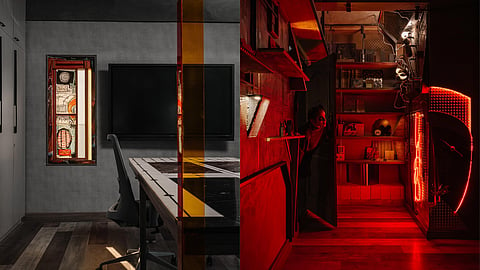
- HOMEGROWN WORLD
- #HGCREATORS
- #HGEXPLORE
- #HGVOICES
- #HGSHOP
- CAREERS
- ABOUT US
- CONTACT US

Waste and discards from modern economic and industrial systems play a crucial role in both creating the Anthropocene and in marking its place in the geological record. A defining characteristic of modern waste is its remarkable lifespan. Much of the waste produced now will persist over vast geological timescales and will remain long after humans are gone, not necessarily due to a rapid human extinction (which remains uncertain!), but because this waste will outlast any species in Earth’s history.
'Requiem of Ruins', a self-initiated material lab designed by Smitha Thomas' design studio, Multitude of Sins, is both a spatial experiment and a philosophical statement against the excessive waste we produce in the pursuit of utopia.
Multitude of Sins’ practice blurs the boundaries between design, performance, and philosophy. The award-winning multidisciplinary studio’s projects are less about form and function than about the psychological implications of spatiality — how perceptions of time and space, memory, and sensory dissonance can shape experiences. Requiem of Ruins is an extension of that pursuit: a labyrinth where one navigates not only walls and corridors but states of mind.
Born of a two-year excavation of the overlooked, a slow, deliberate gathering of discarded materials from past projects, the material lab addresses the mounting issue of construction waste — transforming 95% salvaged materials into a living, breathing hub. These materials define the space entirely, forming its structure, surfaces, and environment. The lab serves as a catalyst for rethinking sustainability in design. Located in a renovated apartment that has been reimagined into an immersive environment, the lab blurs the lines between workspace and art gallery.
The lab draws from the aesthetic and moral contradictions embedded in modern cities: the simultaneous urge to build and to destroy, to preserve and to erase. In Bangalore, where glass towers are rapidly replacing colonial bungalows, Requiem of Ruins proposes an alternative: what if the ruin itself were the only monument of our times? It invites questions about what it means to create permanence in an age defined by collapse. The ruin, traditionally seen as a relic of the past, here becomes an active site of renewal and transformation.
By framing the ruin as an active condition, Requiem of Ruins invites a reconsideration of what we call progress. The project asks: what if the act of building were about participation rather than permanence — about engaging with entropy, embracing fragility, and finding beauty in the unfinished?
Follow Multitude of Sins here.
If you enjoyed reading this, here’s more from Homegrown:
Cavya Sound Is A Studio Highlighting The Multiplicity Of The Tamil Cultural Experience
Algae, Glass, & Bioleather: Inside Devanshi Jain’s Radical 'Neo-Luxury' Design Practice
Architecture Meets Emotion Through The Structural Poetics Of Asad Hossen’s Art
